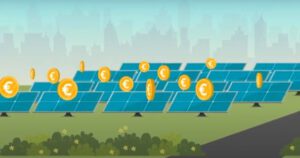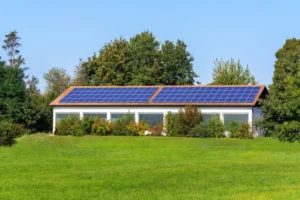Manual / Generate passive income with photovoltaics - Here's how!...Read more
Generate passive income with photovoltaics - here's how!
Passive income through photovoltaics
In times of rising electricity prices and growing environmental awareness, more and more people are looking for ways to generate passive income.
One of the most attractive and sustainable options is to invest in photovoltaic systems or to lease roof or open spaces suitable for photovoltaics.
These systems use the power of the sun to generate electricity that you can either use yourself or feed into the public grid - and thus build up a long-term, regular income stream.
But how exactly does it work and what advantages does photovoltaics offer as a source of income?

How passive income works with photovoltaics
Feed-in tariff: Passive income through solar energy Passive income means earning money without having to actively work for it - with photovoltaic systems, the sun does the work.
As soon as the solar system is installed, it continuously produces electricity from solar energy. The electricity generated can either be consumed by the customer or fed into the public grid.
With the feed-in tariff, surplus, unused electricity is fed into the public grid. In return, you receive remuneration from the grid operator for every kilowatt hour (kWh) fed into the grid.
This remuneration runs for several years and provides a regular, passive income.
Depending on the size of the system and the amount fed into the grid, this can lead to a regular passive income that remains stable for years.
The advantages of photovoltaics for passive income
Sustainable and environmentally friendly source of income
A photovoltaic system actively contributes to environmental protection,
by producing clean energy. This reduces your personal carbon footprint and promotes the energy transition.Long-term returns
Once installed, photovoltaic systems are low-maintenance and have a long service life - often over 40 years. The investment costs are amortized after a few years, after which the system generates passive income at virtually no additional cost.
Tax advantages
Investments in photovoltaic systems are supported by government subsidies and tax relief. This can make it easier to get started and increase returns.
Costs and subsidies for photovoltaic systems
The purchase of a photovoltaic system requires one-off investment costs, which vary depending on the size and quality of the system.
However, this investment can be claimed against tax through the investment deduction and thus reduced. The decisive factor for the profitability and return on investment of the system is that the initial costs are offset by the feed-in tariff, electricity savings and possible subsidies over a certain period of time.
As a rule, the investment pays for itself after just a few years, which means that an attractive return can be achieved in the long term.
KfW promotional loans
The Kreditanstalt für Wiederaufbau (KfW) offers favorable loans for investments
in renewable energiesFeed-in tariff
Depending on the amount fed into the grid, you receive a payment per kilowatt hour fed in. This is set by law and remains constant for years
Regional subsidies:
In many federal states, there are additional regional funding programs for
private investors.
Surplus solar power can be fed into the public grid, for which operators receive remuneration. This feed-in tariff provides a reliable and long-term source of income.
Risks and challenges
The purchase of a photovoltaic system requires one-off investment costs, which vary depending on the size and quality of the system.
However, this investment can be claimed against tax through the investment deduction and thus reduced. The decisive factor for the profitability and return on investment of the system is that the initial costs are offset by the feed-in tariff, electricity savings and possible subsidies over a certain period of time.
As a rule, the investment pays for itself after just a few years, which means that an attractive return can be achieved in the long term.
As with any investment, there are a number of factors that need to be considered with photovoltaic systems - but these also offer opportunities if they are addressed correctly:
Weather dependency:
Although electricity production depends on solar radiation, modern photovoltaic systems are designed to achieve efficient yields even in less sunny regions. With optimized technology, such as intelligent storage systems, the energy yield can be maximized - regardless of seasonal fluctuations.
Changes to the feed-in tariff:
Even if the feed-in tariff may change in the future, photovoltaic systems still offer a long-term source of income. Even in the event of possible adjustments, the investment remains attractive as the remuneration is fixed for the duration of the contract period. In addition, many governments ensure stable framework conditions to guarantee the profitability of the systems over many years.
Changes to the feed-in tariff:
Photovoltaic systems are extremely low-maintenance and designed for a long service life. However, should a repair or replacement of components such as the inverter be necessary, we not only offer professional maintenance services, but also comprehensive insurance to protect our customers from unexpected costs. This keeps the system running efficiently and cost-effectively for decades.
Conclusion: Photovoltaics as a source of passive income
Investing in a photovoltaic system offers an attractive opportunity to generate passive income in the long term. The system produces electricity almost free of charge as soon as the investment costs are covered, and you benefit from tax advantages and government subsidies. At the same time, you make a contribution to the energy transition.
If you have the financial means, you should consider photovoltaics as part of your investment strategy. In addition to the financial benefits, the system provides greater independence and protects the environment - a combination that will become increasingly important in the future.



